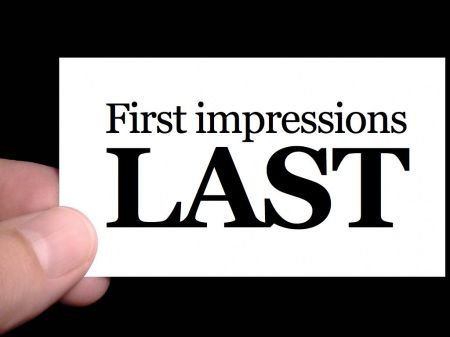My wife has an amazing ability to read people and judge them within seconds of meeting them. Over the years I have challenged her many times, telling her not to judge a book by its cover but to get to know someone properly first. Time has shown that her first impressions were always right.
We don’t all have that ability – I know I don’t – but we do tend to remember our first impressions of people most. Right or wrong, first impressions certainly do last – and sometimes, they are the only impressions you’ll have the chance to give. Your first impression is your business card, in effect, and it will determine whether a person calls you back, uses your services, or stays to listen to you.

This is just as important when you are presenting, even if your audience doesn’t have the ability to get up and leave before you have finished. There are two key reasons for this.
The first is that you need to give people a reason to want to listen to you. If you don’t make them want to listen right at the start, they probably won’t. If their first impression is that you are going to bore them senseless, their survival instinct will kick in and they will decide to do something less boring instead. Like doodling. Or email. Or tweeting. Or checking the cricket score. Or examining the inside of their eyelids.
The second is what’s known as the ‘primacy principle’. This states that people remember most what you say first. So if you have a particularly important message, you might want to say it right at the start, and then use the rest of the talk to explain why, rather than build up to it logically and methodically and then reveal your moment of wisdom at the end. A presentation is not a whodunnit. If the butler did it, say so at the start, then explain your reasoning.
So your introduction is extremely important. Here are five things you need to achieve in your first minute or so:
1. Connect with your audience. The best presentations are more about two-way communication than about simply broadcasting a message as if the audience were not there. Even if you as the presenter are doing almost all the talking, it is important to make the audience feel a part of what you are doing. For example, if you are going to present in a different country, pick up a local newspaper and find something interesting which you can mention at the start, or tell a story about what happened to you in the taxi from the airport, or last time you were there. Something like that will tell the audience that you’re not just going to give them exactly the same talk you have given ten times before to ten different audiences. It’s personal. It’s a talk specially created for them.
A few words in the local language can be powerful as well, as Presidents Kennedy and Reagan both memorably used in their Berlin speeches.
2. Establish your credibility. If your audience doesn’t respect you as an authority on your subject, they won’t listen properly. Being respected is one of the four aims of presentation, and it is one you need to achieve right at the start. Imagine an unknown presenter talks for an hour about how to become a great tennis player. Why would you listen? Then at the end, he reveals that he’s Roger Federer‘s coach. Suddenly he has immense credibility, but you can’t go back and be more attentive – it’s too late. Establish your credibility at the start (or even before you take the stage).
3. Explain the purpose. After your introduction, it should be clear to the audience what you are going to talk about, and why it is important for them. (Not for you – for them.)
4. Set expectations. This is where you make sure the audience knows what they can expect, and what they should not expect. If you’re going to talk about mobile app development but you are not going to cover Android, make that clear at the start – otherwise some people might wait and wait for you to cover Android, and then get disappointed when you don’t. You should set positive expectations – and then make sure you meet or exceed them.
5. Make them want to listen. Your introduction has to give the audience a reason to listen more. This could be because you are amazingly engaging or funny, or it could be because the problem you are talking about is relevant to them. If you are going to talk to a group of German engineers about the reproductive difficulties of Andean llamas, that could be tough, so choose your subject well, but if in fact there is a relevant engineering challenge in solving Andean llama reproduction problems, make sure that’s clear at the beginning.
CONCLUSION
First impressions aren’t always fair. If you walk into the room wet through because somebody took your umbrella, your first impression won’t be a good one. If you spend ten minutes trying to make your slides appear on the wall, that doesn’t look too good either. It’s not just about what you say.
So do everything you can to ensure that your first impressions are positive, in how you appear, what you do and what you say, and that will end up being a lasting positive impression.
Otherwise, you’ll just have to pray that my wife isn’t in the audience.
[…] envie d’aller plus loin, c’est comme les mauvais PowerPoint chers à Garr Reynolds ou Phil Waknell. Ce dernier a d’ailleurs écrit un très bon billet (en anglais) intitulé First impressions […]